#Shrink Films Industry
Explore tagged Tumblr posts
Text
Exploring Emerging Trends in Shrink Films Procurement Intelligence
The shrink films category is anticipated to grow at a CAGR of 6% from 2023 to 2030. Three primary types of films are used in shrink wrapping or packaging: polyvinyl chloride (PVC), polyolefin (POF), and polyethylene (PE). Shrink films can be converted into bags, flattened roll stock, overwrap, tubing, and banding. Shrink films can also be segregated into centerfold and single-wound films. These are mainly made from POFs and PE. PVC shrink films are extensively used for non-food goods such as CD and DVD packaging, game and software boxes, and other packaging. This is because PVC is banned in many countries due to its chemical composition and the hazardous by products that are generated during its synthesis and decay. Hence, companies such as Walmart take extra precautions and ensure the highest standards for use and disposal when certain manufacturers use this chemical in their packaging.
In the plastics packaging industry, the key trend is the increasing focus on sustainability. Considering the increasing momentum of the anti-plastic movement, there are significant concerns about the usage of shrink wrap/films in the packaging industry. However, most of the films are produced using LDPE, the production of which does not emit polluting agents and is recyclable in most cases. As a result, companies are increasingly trying to implement environmental-friendly plastics or recycled content while manufacturing films or wraps. One such instance is the use of green polyolefin film, which can help companies achieve more than 25% in annual savings.
Strong robust demand from the F&B, electronics, pharmaceutical, and cosmetics sectors has contributed to the increasing requirement for shrink films. By consumption, the F&B sector accounts for the largest share, between 45 - 55% of the total. The rise in canned, packaged, and frozen food and the growing concerns about products during transit has led to the further expansion of shrink-wrap/film packaging. In addition, rising awareness among consumers about packaging is also positively impacting the industry. For instance, in 2022, it was found that 74% of customers are prepared to pay extra money for packaging that is fully recyclable or sustainable.
According to industry experts, as of April 2023, the PPWR proposal particularly in the European region could have a tremendous negative impact on the shrink films/wrap market. The proposed regulation intends to eliminate or drastically cut down on the usage of pallet wraps, shrink wraps, and stretch films made of polyethylene for transit packing. This poses a risk to all European Union producers and users of these wrapping products.
Order your copy of the Shrink Films Procurement Intelligence Report, 2023 - 2030, published by Grand View Research, to get more details regarding day one, quick wins, portfolio analysis, key negotiation strategies of key suppliers, and low-cost/best-cost sourcing analysis
The global shrink films category is fragmented. Regionally, plastics, polymers, and in turn, the shrink films industry is highly fragmented. As a result, the bargaining power for most of the suppliers is moderate to low. Large corporations having long-term agreements with their approved vendors may have higher negotiation power. Most of the manufacturers prefer using POFs due to their excellent durability and versatility properties. It is made of 100% recyclable material, which further helps companies contribute to sustainability. POFs have replaced PVC in many applications, and it also has received FDA certification for food packaging applications. In July 2023, Amcor announced the introduction of a new sustainable production line in its Swansea, U.K. “Flexibles” facility. The line is mainly for shrink films and bags for cheese and meat items. It is produced using thinner material with a formulation that is devoid of PVDC and has a high barrier.
Some of the key cost components associated with the category include raw materials, energy and equipment, labor, facilities and storage, transportation, and others. Other costs can include marketing, repairs, utilities and administrative expenses, tax, etc. The key raw materials for films include POF, PE, or PVC. POFs fall under the thermoplastics family and hence can utilize multiple raw materials such as ethylene, and propylene. These are again obtained from oil and natural gas. As a result, fluctuations in the prices of the raw material can have a significant impact on the cost of shrink film. For instance, price increases in the resin markets at the end of 2021 caused shrink wraps and film prices to increase by 8 - 12%. In the European region, the majority of polymers followed the increases in monomer prices, and polyolefin prices continued to grow in October 2023. Propylene C3 increased by EUR 60/ MT, while ethylene C2 increased by EUR 65 / MT.
The total cost is also impacted by certain variables such as the width and thickness of the film, package height, type of material used, etc. In addition to the unique formulations of the films, there is an increased cost when companies want printed designs. Printed shrink wraps/films are considered a premium option with branding, typography, logo, and graphic dynamics. It is more expensive than transparent or clear films. For instance, clear centerfold shrink films can cost on average between USD 100 - 250. Prices can vary based on roll orders. The cost of a printed pallet wrap order can easily range between USD 5,500 - 6,000, assuming the minimum order is 40 rolls (for machine pallet wrap).
According to Volza's October 2023 estimates, the top exporters of shrink films are China, India, and Vietnam, accounting for 38,769 shipments, 18,349 shipments, and 18,043 shipments respectively. The majority of the world's shrink films are exported to Vietnam, India, and the U.S. APAC dominated the shrink wraps and films category as it held 43% of the share in 2022. Most of the companies procure raw materials from China owing to its huge network of plastics and polymers supplier base coupled with manufacturing capacity. Under sourcing, most of the packaging companies such as Amcor, Mitsubishi Chemical Corporation, and Berry Global have their complete in-house plastics or dedicated flexibles manufacturing plants. Such corporations may have procured raw materials from their approved suppliers, however, film manufacturing from start to finish is done by the in-house team.
Shrink Films Procurement Intelligence Report Scope
• Shrink Films Category Growth Rate: CAGR of 6% from 2023 to 2030
• Pricing Growth Outlook: 10% - 15% (Annually)
• Pricing Models: Volume-based, contract-based pricing model
• Supplier Selection Scope: Cost and pricing, past engagements, productivity, geographical presence
• Supplier Selection Criteria: Material type (PVC, PE, or POF), application (food, bottles, sensitive products), features (tamper resistant, moisture and oxygen barrier), certifications, operational and functional capabilities, technology used, and others
• Report Coverage: Revenue forecast, supplier ranking, supplier positioning matrix, emerging technology, pricing models, cost structure, competitive landscape, growth factors, trends, engagement, and operating model
Browse through Grand View Research’s collection of procurement intelligence studies:
• Polyethylene (PE) Film Procurement Intelligence Report, 2024 - 2030 (Revenue Forecast, Supplier Ranking & Matrix, Emerging Technologies, Pricing Models, Cost Structure, Engagement & Operating Model, Competitive Landscape)
• Conveyor Procurement Intelligence Report, 2023 - 2030 (Revenue Forecast, Supplier Ranking & Matrix, Emerging Technologies, Pricing Models, Cost Structure, Engagement & Operating Model, Competitive Landscape)
Key Companies Profiled
• Amcor Plc
• Berry Global Inc.
• Bolloré Group
• Sealed Air Corporation (SEE)
• The Dow Chemical Company
• Bonset America Corporation
• Allen Plastic Industries Co., Ltd
• Barbier Group
• Mitsubishi Chemical Corporation
• American Eagle Packaging
Brief about Pipeline by Grand View Research:
A smart and effective supply chain is essential for growth in any organization. Pipeline division at Grand View Research provides detailed insights on every aspect of supply chain, which helps in efficient procurement decisions.
Our services include (not limited to):
• Market Intelligence involving – market size and forecast, growth factors, and driving trends
• Price and Cost Intelligence – pricing models adopted for the category, total cost of ownerships
• Supplier Intelligence – rich insight on supplier landscape, and identifies suppliers who are dominating, emerging, lounging, and specializing
• Sourcing / Procurement Intelligence – best practices followed in the industry, identifying standard KPIs and SLAs, peer analysis, negotiation strategies to be utilized with the suppliers, and best suited countries for sourcing to minimize supply chain disruptions
#Shrink Films Procurement Intelligence#Shrink Films Procurement#Shrink Films Market#Shrink Films Industry
0 notes
Text
Pallet Wrapper Machine Manufacture - Innovative WrapTech Pvt. Ltd.
Leading Pallet Wrapper Machine Manufacturer providing safe, effective, and long-lasting pallet packaging solutions. Increase your output right now.
#Wrapping Machine#Stretch Wrapping Machine Manufacturer#Stretch Wrapping Machine Price#Innovative Wraptech Company#Coil Stretch Manufacturer and Supplier#Vertical Coil Wrapping Machine Manufacturer#Coil Stretch Wrapper Manufacturer#Industrial Pallet Wrapping Machine Supplier#Shrink Wrapping Machines Manufacturers#Coil Stretch Wrapping Machine#Coil Wrapping Machine#Coil Wrapping Machine Manufacturer#Vertical Coil Stretch Wrapping Machine#Vertical Coil Wrapping Machine#Horizontal Coil Stretch#Coil Stretch Wrapping Machine price#Horizontal Coil Wrapping Machine#Coil Master Wrapper Machine#SS Wire Coil Packing Machine#SS Wire Coil Packing Machine Manufacturer#G.I Wire Coil Wrapping Machine#G.I Wire Film Wrapping Machine#Semi Automatic Vertical Coil Wrapping Machine#Vertical Coil Packing Machine#Rope Wire Coil Wrapping Machine#Drip Irrigation Pipe Wrapping Machine#Drip Pipe Wrapping Machine#Galvanized Wire Packing Machine#Big HDPE Pipe Stretch Wrapping Machine#Lateral Pipe packaging machines
0 notes
Text
The Plastic Films Market is experiencing rapid growth driven by rising e-commerce
The plastic films market enjoys widespread applications across various end-use industries such as packaging, agriculture, construction, and electrical & electronics. Plastic films offer several advantages over traditional materials including moisture barrier properties, durability, lightweight and transparency. They are extensively used for flexible packaging of food products, beverages, consumer goods and industrial applications. The growth of e-commerce and online shopping has propelled demand for plastic films from the packaging sector. The Global Plastic Films Market is estimated to be valued at US$157.5 billion in 2024 and is expected to exhibit a CAGR of 7.2% over the forecast period 2024 to 2031. Key Takeaways Key players operating in the plastic films market are Amcor plc, Berry Global Group, Sealed Air Corporation, DuPont, Toray Industries, Jindal Poly Films, RPC Group, and DS Smith. They collectively account for over 30% share of the global market. The Plastic Films Market Demand has been witnessing strong growth globally driven by the expanding food & beverage industry and burgeoning e-commerce sector. Especially in Asia Pacific, growth in the standard of living has boosted consumption of packaged foods and beverages, thereby augmenting plastic films usage. The plastic films market is extending its footprint globally on account of rising export activities from leading producers based in Asia Pacific and Europe. Many developing countries in South America, Middle East & Africa and Asia are emerging as lucrative markets providing ample opportunities for plastic film manufacturers. Market Key Trends One of the key trends gaining momentum in the plastic films market is the increasing replacement of conventional plastics with bioplastics. Bioplastic films made from renewable sources such as cellulose, starch, polylactic acid and polyhydroxyalkanoates offer superior compostability and sustainability. The development of bio-based barrier films, shrink films and stretch films with properties comparable to petroleum-based films will further bolster the adoption of bioplastics in food packaging and other applications over the forecast period.
Porter's Analysis Threat of new entrants: Low capital required for manufacturing plants enables easy entry which increases competition in the market. Bargaining power of buyers: Large number of suppliers in the market gives buyers more options but commodity nature of products limits their power. Bargaining power of suppliers: Major suppliers have established relationships with end-use industry players reducing their individual bargaining power. Threat of new substitutes: Availability of alternative materials like paper and aluminum foils poses threat of substitution to plastic films. Competitive rivalry: Large number of global and regional players operate in a price-sensitive market increasing competition. Geographical Regions North America accounts for the largest share of the plastic films market owing to high demand from various end-use industries like packaging, personal care, construction and others in United States and Canada. Asia Pacific region is expected to grow at the fastest rate during the forecast period due to rapid industrialization and infrastructure development activities in major economies like China and India increasing consumption of plastic films in packaging, agriculture and construction applications.
Get more insights on Plastic Films Market
For Enhanced Understanding, Dive into the Report in the Language that Connects with You.
French
German
Italian
Russian
Japanese
Chinese
Korean
Portuguese
About Author:
Money Singh is a seasoned content writer with over four years of experience in the market research sector. Her expertise spans various industries, including food and beverages, biotechnology, chemical and materials, defense and aerospace, consumer goods, etc. (https://www.linkedin.com/in/money-singh-590844163)

#Coherent Market Insights#Plastic Films Market#Plastic Films#Flexible Packaging#Polymer Films#Polyethylene Film#Polypropylene Film#Plastic Packaging#Industrial Films#Barrier Films#Shrink Films#Stretch Films#Laminated Films
0 notes
Text

Check out Bagla Group's premium general purpose polyolefin shrink film, ideal for packaging applications. With superior quality and durability, our shrink film ensures optimal protection for your products. Explore our range today! Visit us to know more: https://bagla-group.com/product-category/pof-shrink-films/general-purpose-shrink-films
1 note
·
View note
Text
Bloodborne PSX One of the best fanworks on the web

Though the PS4 boasted and still boasts an impressive library of releases, for many (myself included) the system served to be bought for initially one purpose, to be the Bloodborne Machine. Most of the people in my life who had a PS4 during its generation either bought one exclusively to play Fromsoftware’s Nightmare Hunting Adventure or had initially got one solely to play the game and ended up getting more games afterward. It’s a phenomenon the game industry sees time and time again, with previous generations having swathes of fans buying entire consoles for one or two games. As far as games go though, Bloodborne is at the very least worth the price of entry. At the time, it was heralded as Fromsoftware’s most cutting-edge and impressive game to date. A gorgeous gothic world filled with creatures ripped straight out of H.P Lovecraft’s nightmares, a haunting soundtrack showcasing beautifully composed choral scores and a combat system that incentivized aggression and speed to achieve brutal and bloody efficiency. It’s no wonder then why Bloodborne still has such a large following behind it. Fans of Fromsoftware have hoped for a sequel or PC port year after year to largely disappointing results. But where the community shines is in its fanworks.
From fanart, comics, music, animations, and even fan-made video game spinoffs, the game has been shown a monumental amount of love since its debut in 2015. One of these fanworks was released back in 2022 and has since become one of the most famous pieces of fan-made content surrounding the game, this of course, being BloodbornePSX by LWMedia. An incredibly impressive feat of coding and art direction, the game serves as a “Demake” of Bloodborne’s first Yharnam segment, made to look like and play as if it were made on the very first PlayStation console. With some custom-made areas and an entirely unique boss to boot the perfectly paced experience is both a treat to fans who have been orbiting the game since its earliest days and new fans looking for the best and brightest fanworks to interact with.
The game has since gone on to be covered by a variety of news outlets all over the web, along with its creator receiving much-deserved attention for her efforts. One Lilith Walther (AKA b0tster on social media) holds the title of developer for the project. A long-time video game enthusiast and FromSoftware fan herself, she’s had quite an impact on the community I’m sure she’s very proud to be a part of. Later in the article, we’ve got an interview with Lilith herself about both Bloodborne PSX and her current project, “Bloodborne Kart”, but first, let’s talk a bit more in-depth about BBPSX.
youtube
(Official launch trailer for Bloodborne PSX, uploaded January 31, 2022 by LWMedia on Youtube)
Bloodborne PSX:
So, what exactly is Bloodborne PSX? To start, let’s answer what precisely a “Demake” is first. Demakes often have the goal of remaking the likeness of a game either stylistically, mechanically, or both, as if it was developed on retro/outdated hardware. Famous examples of Demakes include “The Mummy Demastered” developed by Wayforward as a sort of tie-in to the 2017 film “The Mummy” in the stylings of a 16-bit run and gun adventure against armies of the undead, and “Pixel Force Halo” by Eric Ruth games which take the prolific XBOX franchise and shrinks it down to a Mega Man-esque platformer reminiscent of the NES’ 8-bit days. Demakes are intensely attractive looking, not only into the past of video games and their developments but just how creative developers can be with games that they love and appreciate. Bloodborne PSX hits as hard as a Demake can in my opinion, blending masterfully recreated graphics with perfectly clunky early PSX gameplay quirks that go above and beyond to make the game not only LOOK like it belongs on the nearly 30-year-old console but feel right at home on it as well.
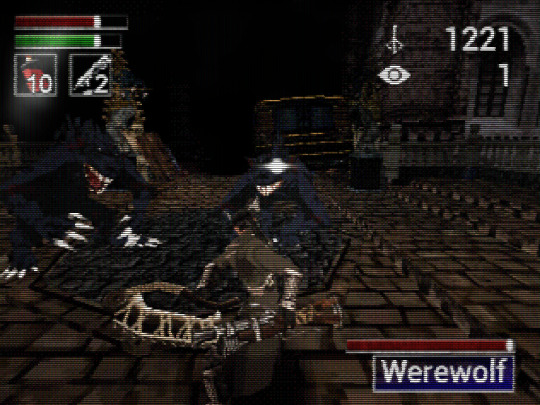
(A screenshot depicting the player character “The Hunter” facing off against two fearsome Werewolf enemies. Screenshot sourced from the Bloodborne PSX Official itch.io page)
Gameplay:
Starting off with the masterfully recreated clunk in the gameplay, Bloodborne PSX “shows its age” by hearkening back to a time when being seamless just wasn’t an option. Much like adventure action games of the past (and much UNLIKE its modern inspiration), you’ll be cycling through your inventory delightfully more than you’d expect. Equipping keys, checking items, and even the trademark weapon transformations are all done through the wonderfully nostalgic menu and inventory screens. Taking one of the foundational parts of Bloodborne’s combat system and making it such a more encumbering mechanic is nothing short of sheer genius when it comes to ways to really make you feel like it’s 1994 again. On top of this, the Hunter’s movement itself has been made reminiscent of classic action titles. Somehow, both stiff enough to feel dated and fluid enough to make combat that same rush of bestial fun found in the original, it goes a long way towards the total immersion into that retro vibe the game sets out to give the player. Anyone who grew up with Fromsoftware’s earlier titles like Armored Core and the King’s Field series will be very familiar with this unique brand of “well-tuned clunk”.
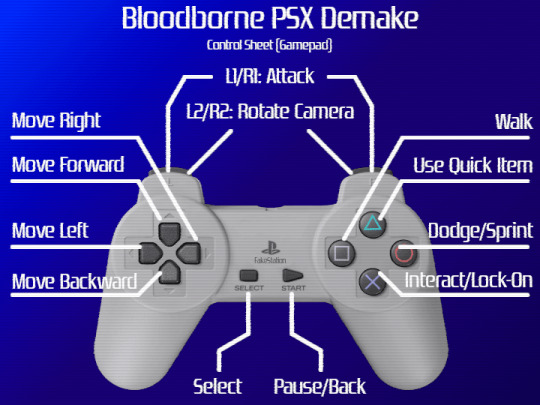
(A delightfully dated looking diagram showing off the controller layout for Bloodborne PSX’s controls. Image sourced from the Bloodborne PSX Official itch.io page)
Graphics:
Speaking of old Fromsoftware games, though, let’s talk about the absolutely bit-crushingly beautiful graphical work on display. As I’m sure you’ve seen from the videos and screenshots included in the article, BBPSX’s art style and direction are nothing short of perfect for what it aims to be. While playing, I couldn’t help but notice every little detail (or lack thereof) in the environments meant to emulate the experience of a game made on 30-year-old hardware. Low render distances, chunky textures, blocky polygonal models, just the right amount of texture warp, it all blends together to create an atmosphere that I can 100% picture being shown off on the back of a jewel CD case with a T for Teen rating slapped into the lower corner. While playing, something rather specific that called out to me was the new way enemy names and health bars were displayed in the bottom right corner of the screen while fighting. As a big fan of the King’s Field games, this small detail went (probably too much of) a long way toward my love of how everything’s meant to feel older. Other games trying to match the more specific feel of King’s Field, like “Lunacid” created by KIRA LLC, also include this delightful little detail, a personal favorite for sure.
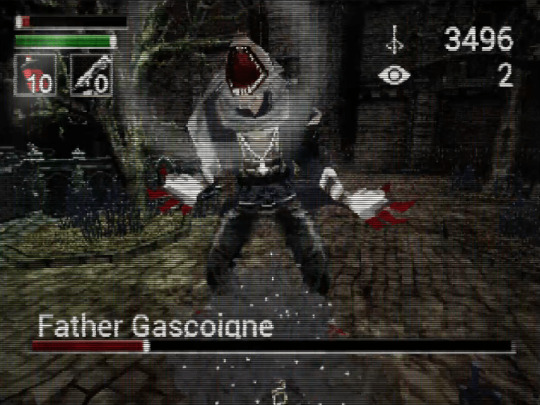
(A screenshot depicting the second phase of Father Gascoigne’s boss fight, showing off the game’s perfectly retro art style. Image sourced from the Bloodborne PSX Official itch.io page)
Sound design/Soundtrack:
But where would a game be without its sound and score? No need to fear, however, because Bloodborne PSX comes complete with a chunky soundscape that will make you want to check and see if your TV is set to channel 3. A haunting set of tracks played by fittingly digital-sounding MIDIs ran through filters to sound just as crackly as you remember backs up crunchy sounds of spilling blood with low-poly weaponry. Original sounds from Bloodborne have been used for an authentic sounding experience, but have also been given the CRT speaker treatment and sound like something you remember playing on Halloween 20 years ago. If you watched the launch trailer featured above then you know exactly what I’m talking about. The Cleric Beast’s trademark screech and Gascoine’s signature howl after his beastly transformation have never sounded so beautifully dated, and I’m here for every bit of it. Even the horrific boss themes we know and love from the original Bloodborne have been brought through this portal to the past. One of my favourite tracks, the Cleric Beast boss theme, might just sound even better when played on a 16-bit sound chip. It really cannot be understated just how much weight the sound design of the game is pulling. In my opinion, the only thing missing is that sweet sweet PSX startup sound before the game starts crackling through the speakers of a TV in the computer room.
youtube
(The Bloodborne PSX rendition of the Cleric Beast’s boss theme. Created by and uploaded to Youtube by The Noble Demon on March 20, 2021)
Interview with the developer:
Before writing this article, I had the absolute pleasure and privilege of talking with Lilith Walther about some developmental notes and personal feelings about inspirations and challenges that can come with the daunting task of being a developer. Below are the nine (initially ten, but unfortunately, a bit of the interview was lost due to my recording software bugging out) questions I posed to Miss Lilith, along with her answers transcribed directly from the interview.
I’d like to start this section of the article by saying Lilith was an absolute joy to talk to. During the interview, I really felt like she and I shared some common ground on some topics regarding how media can have an impact on you and what sorts of things come with video games as an art form. After some minor technical difficulties (and by that, I mean my video drivers crashed), I started off with something simple. The first question posited was: “What got you into video games initially?” Lilith’s response was as follows: “When I was a kid, the family member of a friend had a SNES lying around. I turned it on and didn’t really understand. I was a guy on top of a pyramid, I walked down the pyramid, and some big ogre killed me. Later I learned that was A Link to the past.” and after a brief laugh continued, “A couple years later my parents got a Nintendo 64 with Mario64 and Ocarina of Time and that was it. Never put the controller down since then.”
She then went on to describe what precisely about Nintendo’s first foray into 3D Zelda had hooked her. “I’ve heard this story so many times. It’s like you’re not even playing the game. You’re just in the world hanging out in Kokiri forest collecting rupees to get the Deku shield, and the game expects you to! It was just, ‘run around this world and explore,’ and that really hooked me.” I couldn’t agree more with her statement about her experience. Not just with a game as prolific as Ocarina of Time but many experiences from older console generations that could be considered “the first of their kind”, or at the very least some of the earliest. Lilith also described her first experience with a PlayStation console, stating: “Later on I got a PS2 which played PS1 games. I didn’t end up getting a PS1 until around the PS3 era, so I guess I’m a poser. I remember my sister bringing home Final Fantasy 9 when it was a relatively new game. If it wasn’t my first PS1 game it was definitely my first Final Fantasy game. Of course I went back and played 8 and 7 afterwards.” A solid answer to a simple question.
The second question I asked was one starting to move toward the topic of Bloodborne PSX and its namesake/inspiration. Or at least the family of systems it was released on: “What PlayStation console was your favorite and why?” Lilith’s answer surprised me a bit. Not because I disagreed, quite the opposite, actually. But with such a big inspiration for her work being games from the PSX-PS2 generations, what followed was a pleasant bit of insight into one of her favourite eras of gaming, to quote: “I can give you two answers here.” To which I assured her she was more than welcome to, but she was set on having something definitive. “No no I’m only going to give you one answer. I can give you the correct answer that I don’t want to admit, but it was the PlayStation 3. It’s so embarrassing but I genuinely was hooked into the marketing of the whole ‘The cell processor is the smartest thing in the world’ and all that. It really seemed like the future of gaming and I was all about it. I think I owned an XBOX360 before but I did eventually get it and really enjoyed it. It took a couple years for some of the best games to come out but I really did.” A few examples she cited as being some of her most memorable experiences on the console were Uncharted 2, Journey, Call of Duty 4: Modern Warfare, and Warhawk. All games I’ve seen on several top 5 and top 10 lists throughout my life within the gaming space. A delightful show of affection for a generation personally very dear to me as well, in which she ended the segment by declaring “Hell yeag”, a bit of a catchphrase she’s coined online.
Getting into the topic proper, my third question was one about her personal relationship with Bloodborne: “How did Bloodborne impact/appeal to your interests?” A question that received perhaps my favourite answer of the whole interview. From her response: ”Oh that’s a big one. Going to the opposite end of the poser spectrum, I was a Fromsoftware fan before it was cool. One of the games I played religiously on my PS2 was Armored Core.” A statement which made more sense than perhaps anything else said during my time with her. “Then later in the PS3 era everyone was talking about Dark Souls, this was when I was in college. I finally caved and got it and saw the Fromsoftware logo and thought ‘Oh it’s the Armored Core people!’ I played and beat it, really enjoyed my time with it. I skipped Dark Souls 2 because everyone told me to hate it, I still need to go back to that one.”
It’s something I would recommend anyone who hasn’t played Dark Souls 2 to go and do. “Then Bloodborne came out and I thought ‘Alright this is the new one, gotta play this one’ and I was a huge fan of all the gothic stuff in the aesthetic. And how do I explain this, I do really like Bloodborne. I like the design, and the mechanical suite of gameplay, as a video-gamey video game it’s very good.” The tone shifted here to something a bit more personal. “But as well, I was playing it at a specific time in my life. I came out in 2019, I know Bloodborne came out in 2015 but I was obviously just playing it non-stop. It was just one of my ‘coming out games’, you know?” For those who maybe don’t understand the statement there, “coming out” is a very common term used within the Queer community to describe the experience of revealing your identity to those around you. Whether it be to family, friends, or co-workers, almost every queer person has some sort of coming out story to tell. Lilith is speaking in reference to her coming out as a trans woman. She elaborated: “Obviously I can only speak for myself, but I just feel like when you make a decision like that, that part of my life just ended up seared into my brain, you know? Bloodborne was there, so now it’s just a part of me. And it definitely influenced some things about me. It was there because I was working on Bloodborne PSX at the time, but it had an impact on something I’ve heard a lot of other Trans people describe.” She went on to describe the concept of “Coming out a second time” as sort of “finding yourself more within your identity” and becoming more affirmed in it. She described both Bloodborne and her development on Bloodborne PSX influencing large parts of her life, a good example being how she dresses and presents. As a trans woman myself, this answer delighted me to no end. I, for one, can absolutely 100% relate to the notion of media you experience during such a radical turning point in your life sticking with you. There are plenty of games, shows, music, and books that I still hold very near and dear to me because, as Lilith stated, they were there. All the right things at the right time.
Halfway through our questions, we’ve finally arrived at one pertaining specifically to the development of Bloodborne PSX: “What are some unique challenges you’ve faced developing a game meant to look/play like something made on retro hardware?”
Lilith answers: “So there’s two things, two big things. One is rolling back all of the quality of life improvements we’ve gotten over the years in gaming. Not automatically using keys is always my go-to example.” Something as well I mentioned in my short talk about the game’s gloriously dated feeling gameplay above. “That was definitely very very intentional. Because it’s not just the graphics, right? It was the design sensibilities of the 90s. Bringing that to the surface was very challenging but very fun. Another big part was, since it was one of the first 3D consoles, I wanted to recreate the hype around the fact that ‘ITS IN 3D NOW!’ So if you go into your inventory you’ll see all the objects rendered in beautiful 3D while they slowly spin as you scroll through them.” This is a feature I very much miss seeing in modern video games.
She continued, “I think the biggest one was the weapon changes. Bloodborne’s whole thing was the weapon transformations. Like, you could seamlessly change your weapons and work them into your combo and do a bunch of crazy stuff, and I kind of said ‘that needs to go immediately.’ So now you have to pause and go to your weapon and press L1 to transform it, that was extremely intentional. So once I had those three big things down it all just sort of fell into place. Like the clunky UI and the janky controls. You need jank and clunk, and I think that’s why Fromsoft games scale down so nicely, because they are jank and clunk.”
A point I couldn’t agree with more. Despite all the modern streamlining and improvements to gameplay, Fromsoft’s ever-growing catalog of impressive experiences still contains some of that old-school video game stiffness we’ve (hopefully) come to appreciate. She went on to make a point I was very excited to share here in the article, “It was just a lot of trying to nail the feel of the games and not just the look, right? Like I’m not trying to recreate a screenshot; I’m trying to recreate the feeling of playing this weird game that’s barely holding together because the devs didn’t know what they were doing.” In my humble opinion, something she did an excellent job with.
Fifth on the list was a question relating to her current project, Bloodborne Kart, a concept initially drawn from a popular meme shared around social media sites like Tumblr when the buzz of a Bloodborne sequel was keeping the talking spaces around Fromsoft alight: “Anything to say about the development of Bloodborne Kart or its inspiration?”
Lilith answers: “So first off Bloodborne Kart is less trying to be a simulation of a PS1 game and more just an indie game. It’s not trying to be a PS1 game, I just want it to be a fun kart racer first. Starting off of course is Mario Kart 64, that’s the one I played back in the day. But I looked at other games like Crash Team Racing and Diddy Kong Racing, but also stuff like Twisted Metal of course. I always used those as a template to sort of look at for design stuff like ‘how did they handle what happens to racers after player 1 crosses the finish line.” The next portion of her answer was initially a bit confusing but comes across better when you consider certain elements present in BBK’s battle mode. “And also Halo, like for the battle mode. I had to do a battle mode and it kind of just bubbled to the surface. Split Screen with my sister was such a big part of my childhood. Thinking about Halo multiplayer while I was making the battle mode stuff.”
Her answer to the previous question began to dip into the topic of our sixth question: “Are there any unique challenges or enjoyable creative points that go into making something like Bloodborne Kart?”
As she continued from her previous answer: “One of the biggest quirks of the battle mode I had to figure out was how to tell what team you were on at a glance, and that came back to Halo again. I started thinking about how you could tell in that game and it hit me that the arms of your suit change to the color of whatever team you’re on. It was just something I never even thought of because it’s so seamless. So that gave me the idea to change the kart colours, and that’s the most recent example of me pulling directly from Halo. It’s wild how a small change like that can turn your game from something unplayable to something fun.” I would agree. Tons of small details and things you don’t think about go into making seamless multiplayer experiences. Some of which we take for granted nowadays. She then made a point about one of the most challenging aspects of BBK’s development, “The most challenging thing was definitely the Kart AI. AI is just my worst skill when it comes to game development among the massive array of skills you need to make a game. It’s really hard to find examples of people coding kart driving AI, You know? You need to make a biped walk around you can find a million tutorials online but if you need to make something drive a kart, not really. I was really on my own there. A lot of the examples out there are very simulation oriented. Like cars using suspension and whatnot, but I’m making a kart racer. So I started simple, I put a navpoint down and if it needs to turn left, turn left, if it needs to turn right, turn right. And I just kept adding features from there.”
Moving onto our last three questions, we started to get a little more personal. Question seven being: “What’s your favorite part of Bloodborne Kart so far?”
Her answer was concise in what she was excited about most, quote: “The boss fights.” Short and sweet but she did elaborate. “Translating a big part of Bloodborne is the boss fights. So I made a short linear campaign which is basically AI battles and races strung together. Some of those stages are just boss fights which are unique to the rest of the game. When you make a video game you sit down and you make all your different modes of interactions, and then you make a multi-hour experience mixing and matching all those different modes in more complicated ways. I think the most interesting part is when that style tends to fall away and it ends up building something entirely unique to that experience.” An example she gave was the infamous “Eventide Island” in Breath of the wild, it being a unique experience where the game’s usual modes of interaction are stripped or limited, forcing you into a more structured experience that ends up being a majorly positive one. “That’s what the boss fights are in Bloodborne Kart. They do multiple game mechanics like a chase that ends in a battle mode. Like Father Gascoine’s fight where he chases you, and after you blow up his kart he turns into a beast and picks up a minigun.” That sounds absolutely incredible. It’s very easy to see why she’d pick the boss fights as her favorite element when they’re clearly intended to be such unique and memorable experiences.
Our last two questions veer away from the topics of development proper and focus more on our dear dev’s personal thoughts on the matter. Question eight posits: “What’s your personal favorite part of being a game developer?”
After some thought, she gave a very impassioned talk about something she considers to be the best part of the experience: “When people who aren’t game developers think about game development they think of things like ‘oh well you just get to play video games all day and have fun’ but it’s not! Except for the 2% that is, and it’s near the end of development. When all the pieces fall into place and you start actually ‘making the game.’ Game development, especially solo, you’re so zoomed in on specific parts. Because you’re not making a game you’re programming software that’s what making a game is. You spend months working on different systems and then you actually sit down and make a level, and you hit play and it you go ‘Oh my god, I just made a game’. That part is what sustains me. It’s magical. That’s the best part when it comes to true appreciation of the craft aside from the reception.” An answer that I don’t think I could’ve put better if I tried.
My last question is one that I consider to be the question when it comes to interviewing anyone who works on video games. Perhaps a bit basic, but heartfelt nonetheless: “Anything to say to anyone aspiring to be a game developer?”
Lilith’s answer: “Yes. Just do it. For real. This is what I did and it always felt wrong until I looked at more established devs echoing the sentiment. You cannot plan a game before you’ve started making one. The example I always bring up is the team behind Deus Ex wrote a 500 page design document for the game and almost immediately threw it out when they started development. Just start! You’re going to have unanswered questions and I think that trips people up. Don’t start with your magnum opus idea, start with something simple and achievable. I feel like a lot of people set out with the goal of making a triple-A game, and that’s good! But it can’t be your first game. Game development is creating art, just like any other form of art, and it’s like saying ‘my first drawing is going to be the Mona Lisa’ and it just doesn’t work like that. You need practice and development, and it’s difficult to see that because games take so long and so much, so it’s definitely seen as a bigger undertaking. But it’s still art. You’re still making mistakes and learning from them for your first project. Your next game will be better. View your career as a game developer as a series of games you want to make, and not just one big game.” A perfect response to an otherwise unassuming question.
Lilith’s passion and love for video games were reflected very clearly in every response she gave during my time with her. Her dedication and appreciation for the art form can be seen in every pixel of Bloodborne PSX, as well as the development logs and test builds of Bloodborne Kart. I really do think that the way she answered my final question speaks volumes to the type of attitude someone should take up when endeavoring to make art as intensive as a video game. Whether it’s fanwork of a game that’s important to you or an entirely new concept, do it.
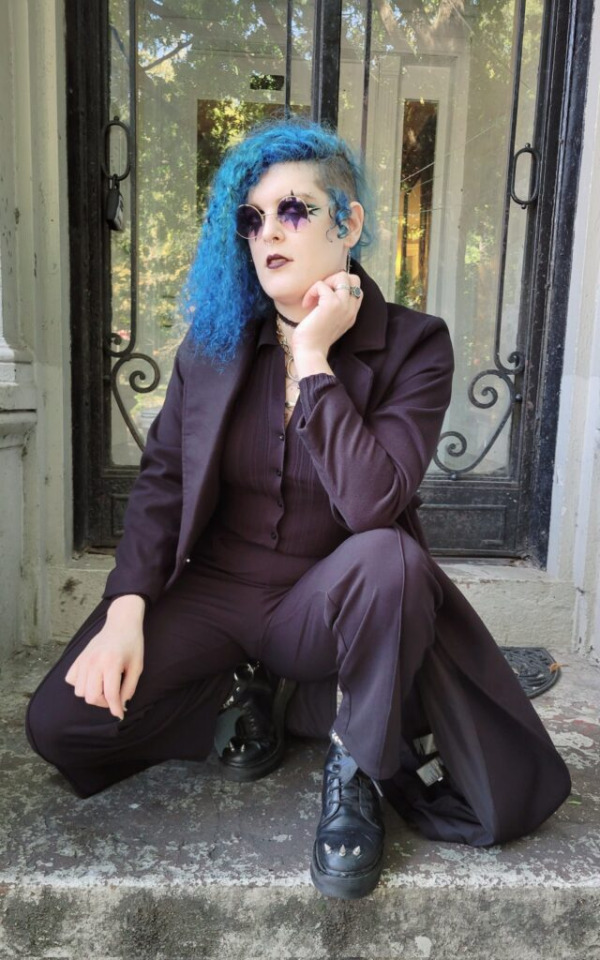
(developer of Bloodborne PSX Lilith Walther, image provided by Lilith Walther via Twitter)
Closing:
If you’d like to check out the positively phenomenal experience that is Bloodborne PSX I’ve included a link to the official itch.io page below the article, as well as a link to the official LWMedia Youtube page where you can check out Lilith’s dev logs, test videos, and animations about her work and other art. Thank you so much for reading, and another very special thank you to Lilith for setting aside some of her time to talk to me about this article. Now get out there and cleanse those foul streets!
Links:
Bloodborne PSX official itch.io page: https://b0tster.itch.io/bbpsx
LWMedia Official Youtube page: https://www.youtube.com/@b0tster
Lilith Walther Twitter page: https://twitter.com/b0tster
#my writing#my stuff#writing#video games#bloodborne#bloodborne psx#demake#article#b0tster#bbpsx#Youtube
660 notes
·
View notes
Note
Since you're Australian, why are so many of the posts from the US? Did you start with Australia and then move onto other countries once you'd felt like you exhausted it? Or is the US particularly interesting for your purposes?
A big part of the reason is the enormous difference in scale. Australia has about 25 million people, versus 300 or so million in the US. Each of the 50 states has at least one or two major cities, most have many more than that. In addition to the volume of real estate imagery produced by this market, there are a few things about the US in this context which draw me in from an Australian perspective. One is how real estate listings weirdly embody how much more visually apparent the harmful economic forces of the past 50 years are in American society than they are here or elsewhere. Australia's welfare state was developed roughly during the same time as in the US, and has similarly been cut back since the 1970s. But it was always much weaker in the US than in Australia or Western Europe, and correspondingly the effects of its deterioration - along with other economic trends - have been much more visible than they are here. The way this is played out in terms of localised funding for public services means that many American cities have pockets (of varying sizes) where poverty and other forms of systemic oppression are concentrated and left open to the elements. The sort of stuff Jacob Holdt documented in his photos in the 70s, or that you see in a lot crime films and thrillers with location shooting. Gentrification and other forces since then have pushed these pockets into other areas and made some places seem less grim, but from what I've heard it seems like it would be hard for the average person in the US to ignore that these large, systemic problems exist. Conversely, in Australia, this kind of intense poverty has been pushed into the margins of society during the same time period - to remote communities (where people suffer from chronic diseases that have been eradicated in most other wealthy countries), country towns with shrinking economies, or to the fringes of larger cities (where people sleep in their cars in parking lots, or multiple families form sharehouses to afford $400-500+ pw rents). Though as things have gotten worse, particularly since COVID, it's getting harder to ignore. But still there's a substantial part of the population here who have grown up in ignorance of any of the larger, percolating structural problems in Australian society, and who proactively retain that ignorance into adulthood.
I think you can see these different perspectives play in out in real estate listings. In most American states, even in most of the towns I've looked at, you can see a broad spectrum of living conditions (and commercial interpretations of ideal living conditions) - from burnt out trailers, to overpriced renovated shitty older houses with cheap grey vinyl flooring and white walls, to clearly lived-in time capsules to McMansions to actual mansions. Some photographs are clearly shot by owners, others by real estate agents with a great variety of care and attention to detail (from elaborate staging to crime scenes). Rightly or wrongly, I feel like I get a broader, more honest (or at least more direct) feel for the housing crisis. It's a more honest horror film.
Australian listings, I think in part due to concentrations in corporate power in the real estate industry (similar to other monopolies that have formed in our economy), tend to more heavily adhere to the visual language of advertising and are more heavily regulated by agencies. The problems still exist, the housing market here is among the worst in the world and little effort is being made to address the underlying structural issues, but you can see the lack of will to acknowledge these issues in the level of gloss that's applied. You can look at a listing of an older house in Western Australia, for instance, and know for a fact that it's riddled with asbestos and probably has several other structural issues, but most likely enough time and effort will have been spent on staging and lighting and maybe surface-level renovations that it will seem otherwise fine. Lots of turds that have been polished successfully enough that you need insider knowledge to properly identify them as dogshit. Incidentally, I spent part of my childhood in a house built in the 1960s that had asbestos in the walls and ceiling.
I'm still interested in images from Australian listings (and other sources) though, I just look for other things that are interesting. Anything that runs contrary to the artificially positive, limited world view that advertising promotes. Even if its a poorly-lit time capsule that is directly aesthetically opposite to the ideal of house-beauty at the moment, or an obviously run-down house that has had every realtor photography trick in the playbook thrown at it until it becomes deeply uncanny. And it's always interesting to see what other people find interesting; I genuinely think the housing crisis underwrites every other political issue we have to contend with, its tendrils extend in many different directions, and I think this also means imagery like this can reach people in a diversity of ways. Aesthetically, nostalgically, inspiring fear and self-loathing and horror. All good sources of inspiration for creativity.
381 notes
·
View notes
Text
People being upset that Joseph Quinn is going to be in MCU movies for at least another three years is so funny to me.
He’s THIRTY.
Harrison Ford was in Star Wars when he was 33, and he’s still acting! One of my favorite roles of his is in Shrinking which came out last year. He’s 82.
Joseph Quinn has LOTS OF TIME to find more projects, and after this he can do EVEN MORE passion projects because he’ll have that kind of power behind his name even more than he does now, which he already has a lot of!
SUPPORT ACTORS DOING PROJECTS THEY ENJOY.
And if that’s a blockbuster Gladiator movie even he didn’t think they could make a good sequel for at first, a short film or three movies in the biggest cinematic franchise in the world, everyone - him, the fans, the industry - only benefits!
#rant#joseph quinn#getting it off my chest#because I see to many posts about everyone acting like the world is ending just because someone joins#mcu#marvel cinematic universe#marvel#actors are working#but some have the advantage of doing lots of projects they love#let them have their fun#the fantastic four first steps#Johnny Storm#avengers#avengers doomsday#avengers secret wars
95 notes
·
View notes
Text
Tim Walz’s Progressive Tax Experiment
The Minnesota economy is no success story on the Governor’s watch.
By The Editorial Board - Wall Street Journal
Our friends in the press don’t seem to care about Tim Walz’s economic record as Governor of Minnesota. But Americans might be interested since it foreshadows where a Kamala Harris-Walz Administration would take the country with their policies.
Minnesota boasts a low employment rate (2.9%), but that’s less impressive than it seems. Nearly all of its job growth under Mr. Walz has been in industries that rely on government spending. Since he entered office in January 2019, Minnesota has added a net 41,500 jobs. This includes 43,900 in healthcare and social assistance and 12,600 in government.
Private industries have lost jobs, including finance, information, professional and business services, retail, manufacturing and leisure and hospitality. Such job losses started before the pandemic but accelerated during Mr. Walz's prolonged lockdowns and have increased during the last year.
Manufacturing employment has declined by 7,500 over the past 12 months, while professional and business services have shed 22,700 jobs. This is especially notable since Mr. Walz last spring signed a giant tax increase, including a 1% surcharge on investment income over $1 million. He also reduced standard deductions for businesses such as for net operating losses.
At the same time he expanded myriad tax credits such as for rent, film production, dependent care and families. Minnesotans can even get a $150 refund for contributing to state political parties and candidates. Such tax credits shrink the tax base so much that Democrats have to keep rates high. Minnesota’s top rate is 9.85% not counting his one-percentage point surcharge—which sends the rich or retired out of state.
Households with roughly $5 billion in adjusted gross income left Minnesota between 2019 and 2022, according to the most recent IRS data. Minnesota in 2022 ranked eighth in income loss among states as a share of overall AGI, after Illinois, New York, California, New Jersey, Alaska, Maryland and Massachusetts.
Top destinations for Minnesota refugees include zero-income tax Florida, Texas and South Dakota. South Dakota’s rate of job growth has been more than four times higher than Minnesota’s since Mr. Walz took the helm. At least overtaxed and jobless Minnesotans can vote with their feet. If Ms. Harris wins, all Americans might have to live by California and Minnesota rules.
#Tim Walz#minneapolis#minnesota#progressive#failure#repost#america first#americans first#america#donald trump#trump#trump 2024#president trump#ivanka#kamala harris#Obama#Biden#Democrats#2024 elections#biden administration#nancy pelosi#conservatives
94 notes
·
View notes
Note
Did Olympe ever shrink down to explore the human town before meeting Ben? If not what is he most excited to learn about human culture?
So Olympe is actually human; he’s the son of an exobiologist and the alien she studied. He was adopted by a friend of his mother’s and never met his biological parents:

His mother (Rowan Asgaya-Dihi) and father (nicknamed “A.V.” or “Ava” for the species - called avis versipellis). The situation you’re describing- shrinking to explore human culture- is much more adjacent to the story of these two! Ava’s species size shifts as a self-defense mechanism, a way of maneuvering through their environment.
But yeah, Olympe, half-bird, was born essentially human-passing, with a set of fleshy wings that eventually grew feathers and hair. Size shifting didn’t manifest until puberty (and he spent a lot of middle school binding his wings with ace bandages to hide them 🥲) here he is, age 15, hiding his wings:

His favorite part of human culture is the moving image :) he loves movies! Writing! Acting! He’s an opinionated dude with a lot to say, and storytelling is his favorite thing in the world. He tried to work in the film industry as a crewman but couldn’t hack it, haha- he met Ben on a film set actually, where they became enemies-to-lovers(!)
He doesn’t know much about his Bird Side (he doesn’t know he’s part alien. He just says he’s “got a condition”)

#olympe is….loosely autobiographical.#thank you for the ask!!! hehehe#I do have a mermaid au of these two where he is a big merman who shrinks down to visit her town 100%#forgive me if that is the story you were asking about#giant tiny#size difference#g/t#gt#olympe#Rowan#Ava#gt asks#g/t thoughts#g/t concept
24 notes
·
View notes
Text
Behind bars
Non Idol! Minji X Convicted! Reader
Description: Coming out of Jail is never easy. Y/n even would say its harder then even getting into Jail. What happens when she lives with a Person that absolutely hates Criminals? What even got her into Jail? and what happens if she starts to like the person that hates her?
Chapter: you have friends?
Masterlist
--------------------------------------------------------------------------------------
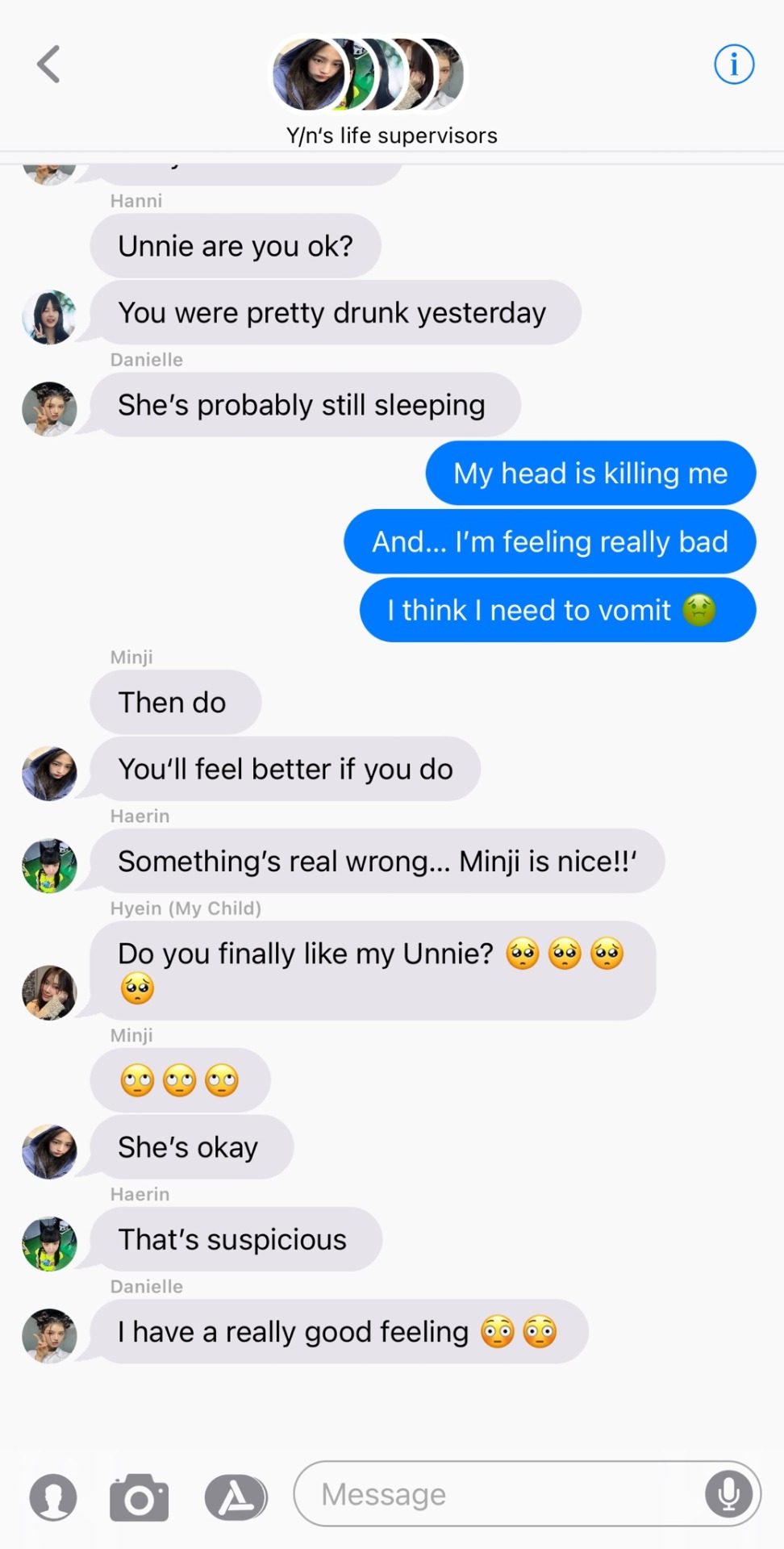
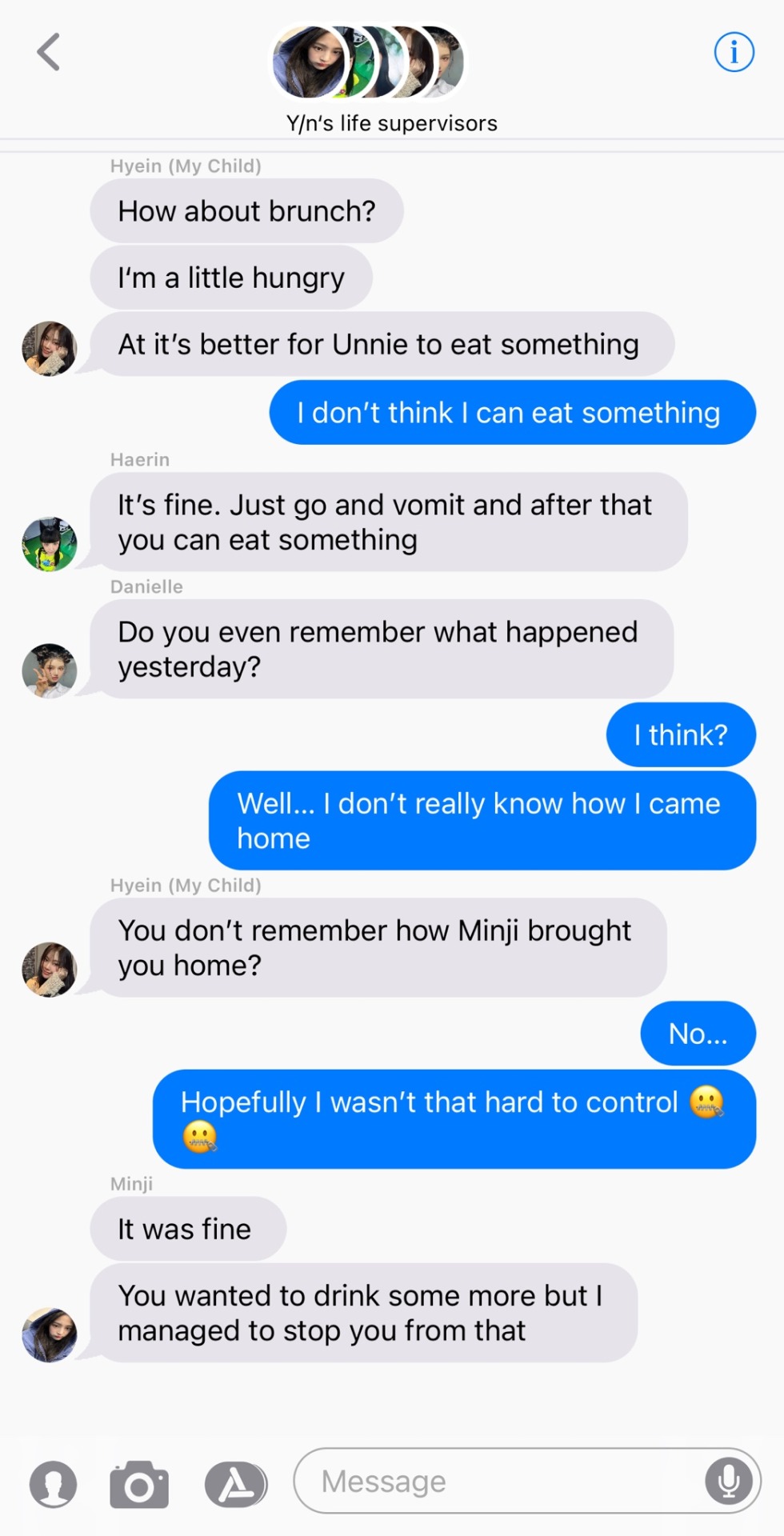
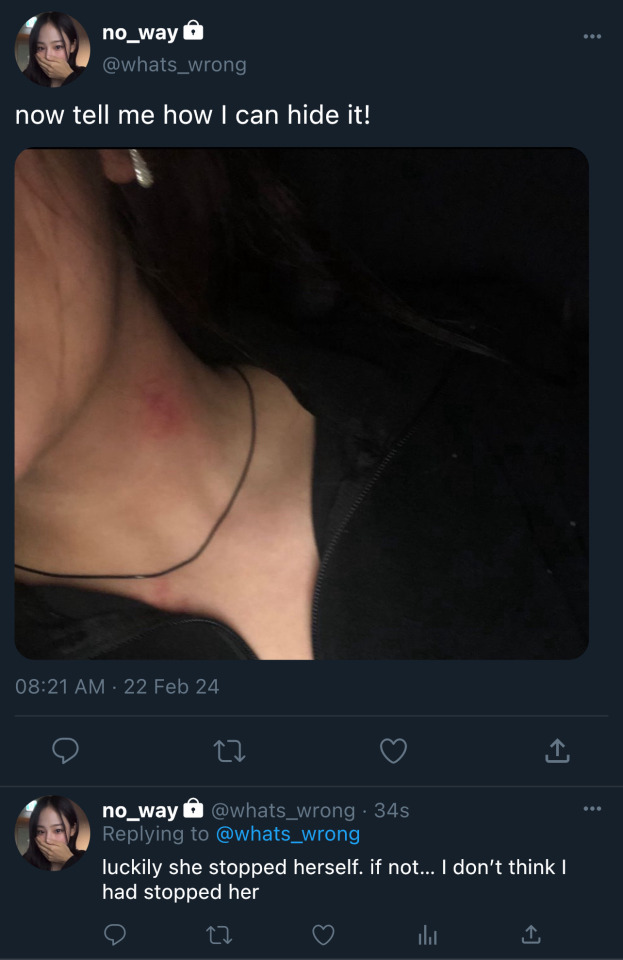
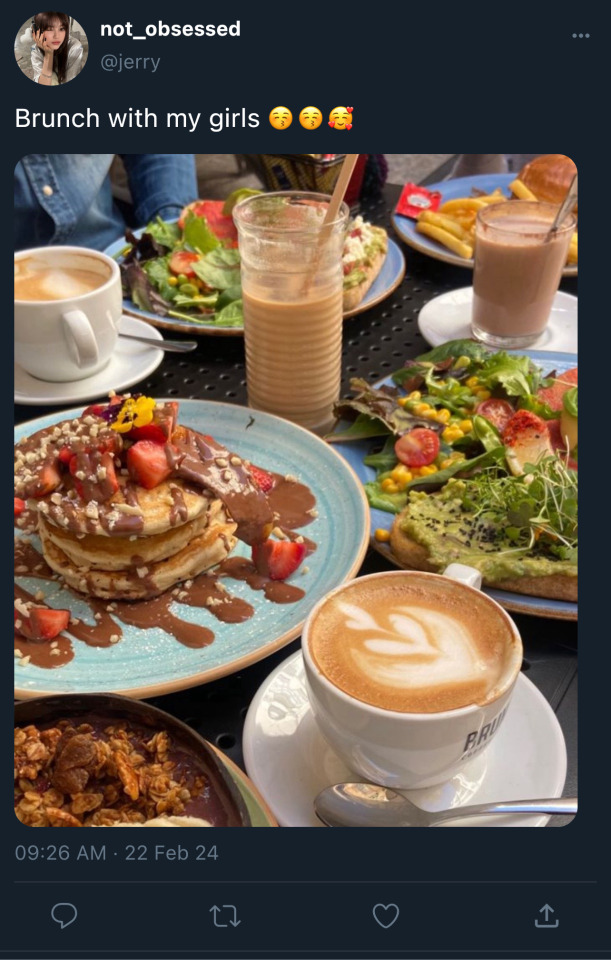
Amazed by the vast selection, I looked at each one. Minji and Hanni were right across from me, with Hyein sitting beside. Danielle and Haerin were in their own little world, which I found quite adorable.
"So, where should I start exactly?" I asked with a light laugh, my cheeks visibly blushing. Hyein smirked, and Hanni was the first to respond, while I could feel Minji's eyes on me.
"It doesn't matter. Begin with what you like," Hanni answered with a smile, gesturing for me to start, probably because I was the oldest at the table. So, I simply grabbed one of the pancakes.
"And? Did you throw up?" Danielle asked curiously, with Hyein immediately complaining that we were eating and this wasn't a suitable table conversation.
I chuckled softly and just nodded at Danielle. This made Dani smile, but she turned her attention back to her girlfriend, as Haerin seemed to want something passed to her.
"I guess I never asked... what do you all do?" I inquired as I looked around. Mainly, I focused on the three whose professions I didn't know.
Danielle smiled at me, pouring orange juice for herself and Haerin. "I'm a model. My mom is a designer, and I model for her clothes," she replied, and I nodded in understanding.
"I'm a writer," Haerin revealed, and my eyes widened. Intrigued, I leaned forward, "Really? Have you published anything?" I asked, and Haerin nodded proudly, sharing details about the four books she had written.
My attention turned to Hanni, who grinned immediately. She set her utensils aside, saying, "I'm a producer," and my eyebrows raised. "I mainly produce music, but I'm also involved in the film industry," she added, leaving my mouth slightly agape.
"Wow... seems like I'm in the company of some high achievers here," I quipped, though I could feel my self-esteem shrinking.
"What about you, Hyein? What are your plans for the future?" I asked, looking at the younger one. "I'm going to be an idol! I got scouted a few years ago, and soon I'll debut. But apparently, only after I graduate," Hyein shared with a big grin. I smiled immediately.
Yes, Hyein was destined to be an idol. She was always singing and dancing, showing interest in Korean idols. While I wasn't particularly interested, I did listen to a few songs from Twice back then.
I turned to Minji, asking, "And you want to be a lawyer?" Minji looked at me, finished chewing, and swallowed her food before answering.
"No. I want to be the Chief Justice of the Supreme Court," Minji replied ambitiously. Her eyes sparkled with determination, leaving me momentarily breathless. I smiled and nodded in understanding.
Everyone had such ambitious goals or challenging professions...
And me?
I'd probably have to work forever in a 7/11 store... maybe even at a gas station.
Nobody would hire someone with a criminal record...
"How about Mimosas?" Hanni asked with a slight smile, glancing around. Danielle declined immediately, with Haerin agreeing. However, I looked at Hanni inquisitively.
"It's Champagne with orange juice. There are different flavors too," Hyein explained as she noticed my questioning gaze. I nodded in understanding.
"Not for me, thanks," I replied with a smirk, but Hanni almost immediately complained. Haerin also voiced her discontent. Dani and Minji remained mostly quiet.
"Okay. But just one glass," I said, laughing lightly.
————————————————————————————
"Here you go," I heard a voice I recognized quite well, and immediately looked up from my meal. My eyes landed on the waitress, and my mouth opened automatically.
The taller woman also glanced at me as she placed the Mimosas on the table. Her eyes widened. I swallowed visibly nervous. "Thank you," I heard Danielle say to the waitress.
The familiar person forced a smile and gave a brief bow. She looked at me once more before disappearing from our table. My eyes followed the waitress.
"What's up? Do you like her?" Hyein asked with a grin, nudging me with her elbow. I blinked, perplexed, and looked at the woman beside me.
"What?" I asked, but I had to clear my throat immediately as my voice broke. Haerin looked at me questioningly. I noticed Hanni and Minji also glancing at the waitress.
"Um, I need to use the restroom real quick," I said, laughing lightly, and stood up from my seat. Everyone looked at me with questioning expressions, making me sigh slightly.
"I won't take long. Feel free to start drinking. Don't wait for me," I said with a smile on my face. I glanced briefly at the familiar waitress before making my way to the bathroom.
The others' eyes were all on my back.
Nervously, I bit my lip as I stood in front of the restroom door. I immediately looked around. Fortunately, a wall obscured the view from our table to the bathrooms.
"What are you doing here?" I heard the familiar voice of the waitress say as she hurried towards me. A smile on her lips as she tightly hugged me. She sighed in relief as she let go.
"Wonyoung," I said, smiling, looking at the taller woman. I appraised the slightly younger one. "The uniform suits you," I quipped, but I almost immediately received a light smack from the taller one as she started giggling.
"Since when have you been out?" I asked, a bit more serious now, leaning against the wall. The waitress mirrored my stance. "Want to smoke while we're at it?" she asked with a light laugh, and I just nodded.
I followed her through the kitchen and out the back door, where most of the staff seemed to be smoking. She grabbed a pack and offered me a cigarette.
"I've been out for about a week," the younger one replied as she exhaled the smoke from her lungs. I nodded, looking around. We were in an alley, next to the business's trash bins.
The street was as lively as ever, with honking cars, people talking, and even the barking of a dog.
"Are you doing okay?" I asked, and Wonyoung chuckled humorlessly. "Well, aside from serving and pleasing these damn rich people," she began as she took another drag, "I'm doing pretty well. I'm out of all that crap," she added, visibly relieving me.
"And you?" she asked after a brief silence. I exhaled the smoke. "I got my diploma... now I'm job hunting," I replied, glancing briefly at my cigarette. "But it'll be tough... Nobody wants to hire someone with a prison record," I sighed, running my left hand over my face in frustration.
"Hey, you're brunching on a Thursday. Can't be all that bad, especially in a place like this, not exactly cheap," Wonyoung remarked, raising an eyebrow.
"Well, I got lucky," I replied with a slight smile, finally looking at the taller one. "My mom's best friend. She took in Hyein and me," I explained, prompting a nod from Wonyoung.
"Hey. Do you have a phone? Let's exchange numbers," Wonyoung suggested, placing the cigarette between her lips as she took out her phone.
I did the same, and we proceeded to exchange numbers. Smirking, I put my phone back in my pocket.
"Wony," I said, speaking a bit softer, causing her to hum. She noticed my expression and stamped out her cigarette on the ground.
"Yeah. She'll be released soon," she murmured, speaking a bit quieter, making me tense. "But that doesn't mean anything! You have a completely new life. No one would expect to find you in places like that," she quickly added, sounding more panicked than before.
"Don't worry. She won't find you," she reassured, placing her hand on my shoulder.
I smiled a bit through her attempt to cheer me up. "Thanks," I said as I headed toward the staff door. "Oh, definitely download Twitter. It's pretty fun," I added, laughing lightly as I disappeared through the door.
With quick steps, I returned to the table where the others were sitting. "Sorry, I'm back," I said, sighing as I took my seat.
Minji furrowed her brow as she scrutinized me. "Did you smoke, Unnie?" Hyein asked, waving her hand to disperse the air around her. "Oh. Do I stink?" I asked, smelling myself a bit, but I couldn't detect any odor.
I chuckled, probably in an attempt to ease my tension, which unfortunately didn't work as well as I hoped.
"So, what did you talk about?"
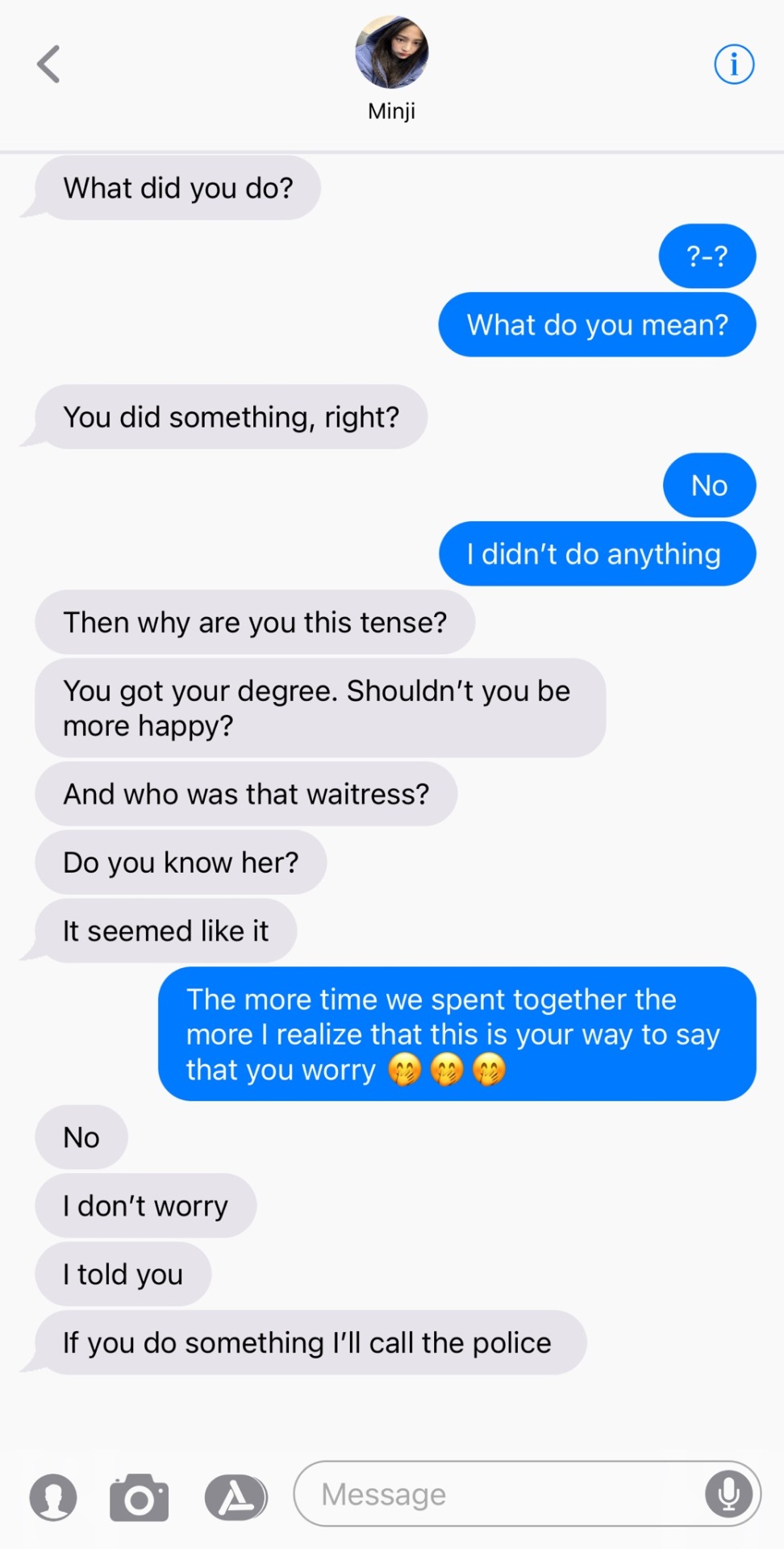
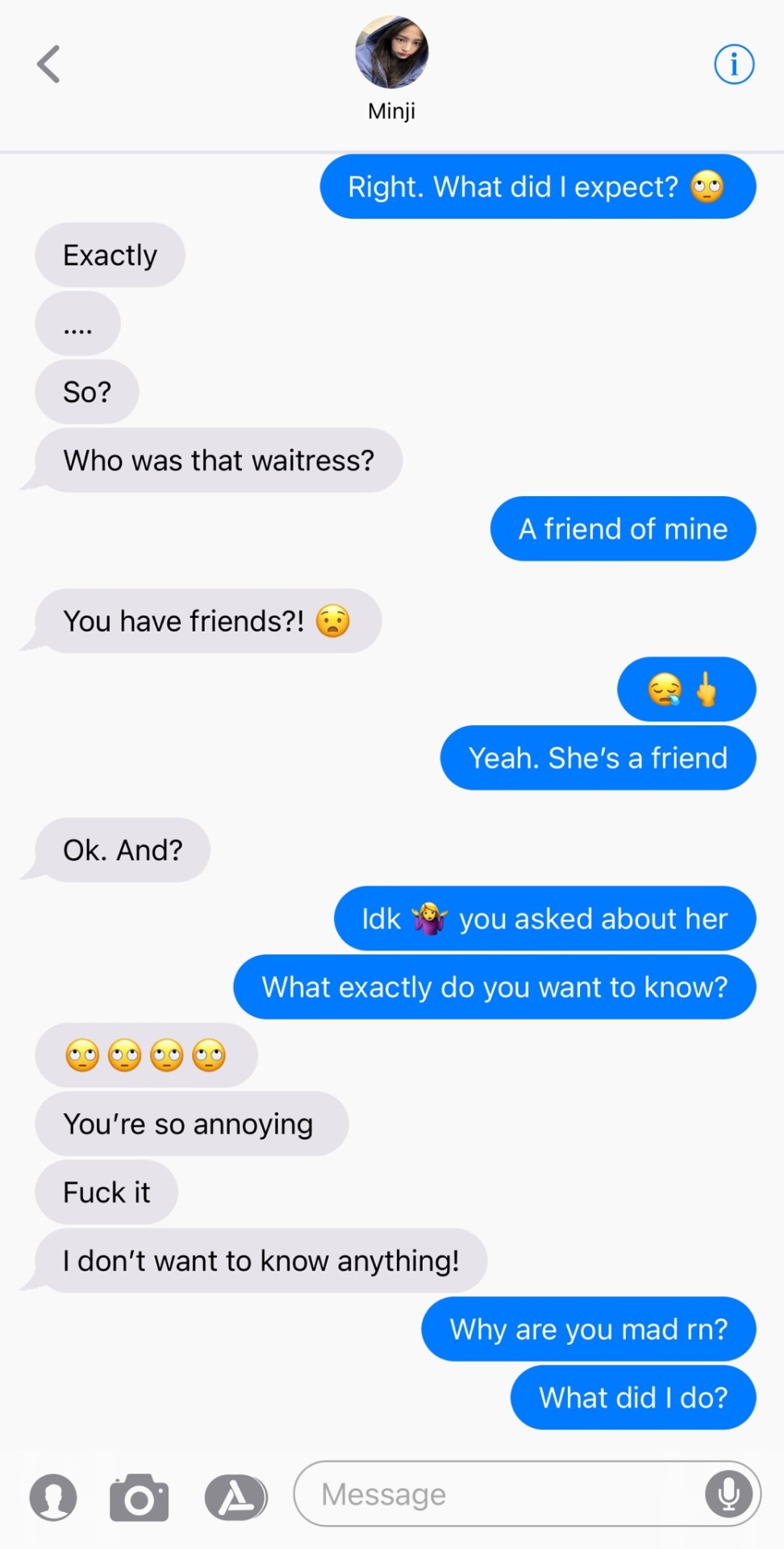
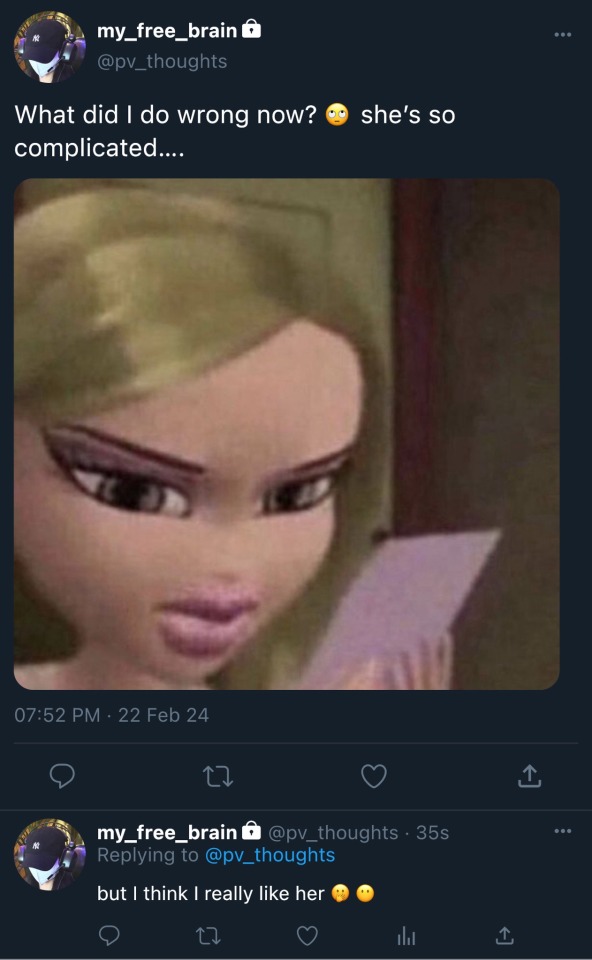
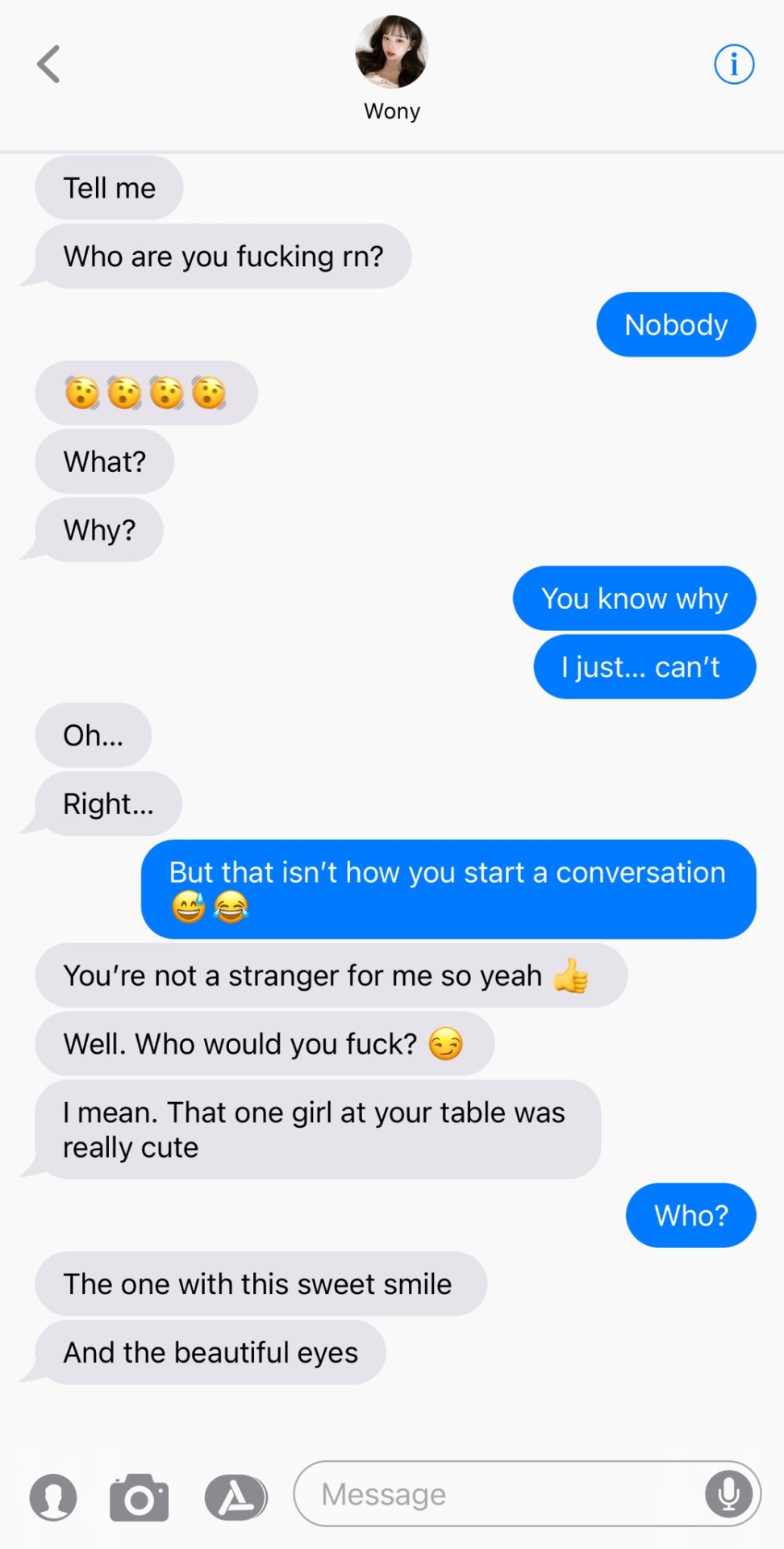
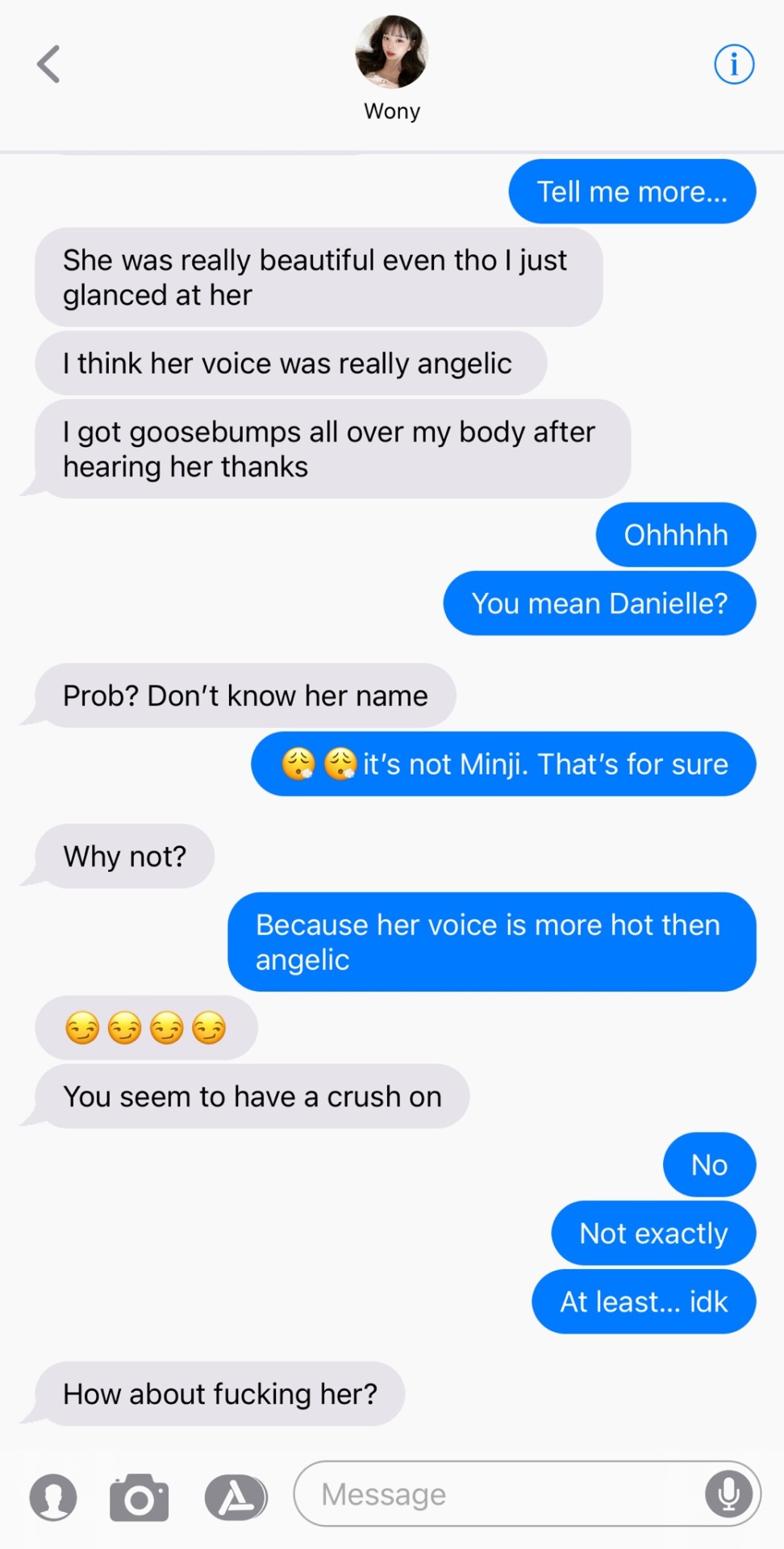
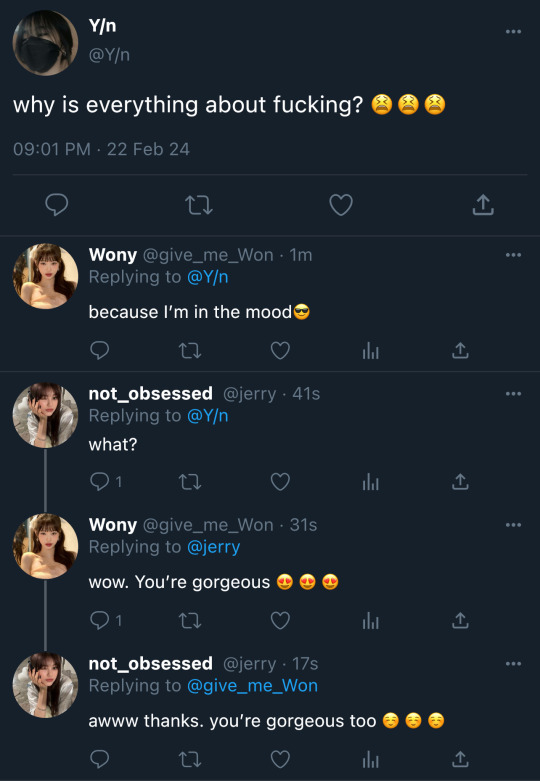
#newjeans minji#newjeans#haerin#danielle#newjeans hyein#newjeans hanni#hanni pham#jang wonyoung#wonyoung#itzy ryujin#shin ryujin#minji x reader
89 notes
·
View notes
Text
BBU: Hollywood
This idea took root and wouldn't let go. Can't say for sure if this will be A Thing, or just a one-off teaser of a thing, but here it is nonetheless.
WARNINGS: BBU, implied noncon, implied noncon drug use, the fucked up film industry
“Cut!”
He doesn’t realize the cameras have stopped rolling until the shrill ring of the bell jolts him back into his body, and out of the one he’s been inhabiting since the last call of action. He doesn’t move, doesn’t blink for a few moments, still caught in the blurry line between characters. Sometimes it takes a few seconds to remember which mask he's wearing.
There is a flurry of movement around him; PAs rush past, murmuring into their headsets, toting plush robes and glass bottles of sparkling water. Hair and makeup swoop in to invade everyone’s space, making their minute adjustments before rolling begins anew.
When he returns to himself, Henry's cheeks are cold with drying tear tracks, and his heartbeat pulses lightly in his lips.
His scene partner is already turned away, her attention attuned to the phone in her hand while a woman with frizzy hair attends to her smudged lipstick. Distantly, Henry knows if he touches his fingertips to his own mouth, they will come away in the same shade of red. Seconds ago, they were locked in an embrace, their tears mingling in the neckline of her silk gown, whispered words of affection spilling between them, and now Henry doesn’t exist. He won’t again until the cameras are pointed at him. Only then does he become alive.
A cold, acrylic nail hooks his chin and turns his head. His personal makeup artist is a woman named Kat in her late thirties with a sleek, blonde bob and smile lines around her eyes. She’s worked on every one of Henry’s films, and she has never spoken to him directly. On instinct, Henry lets his eyes fall shut, slipping back from the surface as she goes through the familiar routine of touching him up.
From behind the wall of his own little world, he allows himself the indulgence of tuning into the conversations around him. A couple of new production assistants—not much older than him—talk about the food truck that production ordered as an end-of-week treat. (This doesn’t apply to Henry. He is on a strict diet of kale and boiled chicken while he's filming. He is always filming). The wardrobe team talks about grabbing a drink at Stanley’s after wrap today. (He knows that Stanley’s is everyone’s favorite spot because it’s less than a mile from the studio, but he’s never seen it for himself). The assistant director comments on her third cup of coffee of the day. (Henry wishes he could ask for some).
The voices fade and flutter until one cuts through the rest.
“One last take, and we’re calling it, David.”
Henry opens his eyes, and Paul stands directly in front of him.
His sleek, black suit stands out among the crew's workwear, and probably costs three times as much combined. It’s hard not to notice the ways everyone’s demeanor changes the moment the Executive Producer steps onto set. In a way, it’s almost reassuring to know Henry isn’t the only one who shrinks in this man’s shadow. But that’s where the commonality ends. They may fear him, too, but at the end of a fourteen hour day, they are not the ones who return home to Paul Maxwell’s bed.
“Our star needs to be red-carpet ready in an hour-thirty.” Though he’s addressing the director, Paul stares directly into Henry’s eyes. “Be sure that he is.”
He doesn’t need to nudge the makeup artist away so much as she instinctively pulls back when Paul lifts a large hand and touches the tips of his fingers to Henry’s jaw. Henry keeps his eyes where they’ve been beckoned and pretends not to notice the assistants in his periphery who duck their faces away from the display of ownership. Paul’s thumb swipes across the corner of Henry’s mouth, taking with it a smear of Eliza Darling’s expensive lipstick. Then, wordlessly, he releases him.
There’s a renewed sense of urgency as Paul retreats from the chaos, but also one of relief that comes with the last shot of the day—for everyone except Henry.
He was up before the sun, and he knows he’ll be out long after it has set. The worst part about interior days: he doesn’t get to see daylight once. Normally, even the call of his Keeper’s bedroom feels like a reprieve after this many hours of shooting. But tonight, his previous film is set to premier on the other side of Los Angeles, and there is no premier without Paul Maxwell’s shining star.
More importantly, there is no after party without him.
There is no time for exhaustion, not for him. When the caffeine pills have run their course, he’ll be given something stronger, and he’ll take it. Whatever it takes to get through the night that will inevitably become a very long weekend.
“You heard the boss,” David says, running a hand through his salt-and-pepper hair. “Let’s make it a good one. Clear frame.”
The makeup brushes make a few last frantic swipes across his skin before they scurry away. Liza Darling tucks a blonde curl behind her ear and presses her phone into a nameless PA’s hand. Henry closes his eyes and slips into another man’s skin.
People tell Henry all the time that he’s lucky to lead the life that he does, in his position. It is only in these fleeting intervals of fiction between reality that he might just agree with them.
For the next three minutes, he does not have to be Henry, nor is he the boy with the name from a life he is not allowed to remember. For the next three minutes, he is Brock Layton: twenty-three, rich, and madly in love.
For the next three minutes, he is as free as he’ll ever be again.
“Sound speed,” the mixer calls out, raising the boom pole over his head.
“Rolling,” camera echoes back.
“And, action.”
#bbu#like bbu adjacent?#whump writing#whump#whumplr#Henry The Sad Little Starling#I've thought a lot about how BBU workers would potentially be used in the entertainment industry#because it is such a brutal and demanding work environment#and how they would have this exterior of glamor and stardom#but it would be a gilded cage as they say#and nothing would be as fun as it seems#I have an urge to write the follow up chapter#the follow up chapter being the red carpet (and the after party which is worse)#and i know what youre thinking:#hey peachy what about the 800 other stories you have started and neglected#and to that i say:
113 notes
·
View notes
Text
Just a reminder to anyone who wants to get into acting or screenwriting to absolutely under no circumstances accept any offers (no matter how good) from any studio that is normally SAG-AFTRA and WGA approved until the strikes are over. Don't cross the picket line. The actors' and writers' unions are currently fighting for fair pay, fair contracts, and ethical working conditions.
Production companies within the AMPTP have started putting out casting calls and screenwriting calls to new talent to try and undermine the strikes. If you take these jobs you are actively helping them continue their unethical pay and treatment of entertainment industry workers and also, once the strikes are over (which they will eventually be), you will likely be blacklisted from the WGA and SAG-AFTRA in the future which will prevent you from acting or writing for future projects. Whether for ethical, financial, or career reasons, it's not worth it.
Don't cross the picket line. Support the strikes. Support the ethical treatment of entertainment industry professionals.
Writers' rooms have been shrinking while the speed and quantity of content they're being asked to produce has been increasing at a rapid rate. They're hiring writers to workshop, then laying them off with no pay or credit for their contributions to preliminary work. In some cases they're using AI to mimic writing styles to fill in the gaps. In some cases they're using AI and just hiring writer's to touch it up. Writers aren't being paid appropriate residuals for streaming service exclusive media, meaning they're getting paid pennies to begin with and then nothing after that no matter how popular shows are (while producers rake in millions).
Actors have been subject to unethical working conditions for ages, from verbal abuse to 24-hour shoots with little to no breaks to other poor working conditions that under the current SAG-AFTRA contracts with the AMPTP are now disallowed. The AMPTP is also pushing for a contract change that would allow production companies to hire actors for a day of filming to train AI, then use their likeness in perpetuity with no compensation for the use of their voice and likeness. Many actors are underpaid and overworked, struggling to make rent, on Food Stamps, and unable to afford health insurance. The AMPTP is pushing for new contracts that would even further exploit and already exploited workforce in a multibillion dollar industry as they line their own pockets.
Stand by the strikes. Don't cross the picket line.
For those who aren't connected to the industry professionally or recreationally, be patient as new shows come to a halt. Be patient as productions get shut down. There's decades of media backlog you can watch instead. No new show is worth the unethical treatment of those who make it. Your new shows can wait. Real people matter more than fictional ones.
167 notes
·
View notes
Text
The 6 Figure Theory
Hello!
In today's blog, I'm getting *spicy*! In that I have a hot take that is of course related to the current state of the entertainment industry, but isn't as directly about comics or writing or editing or what you might usually expect. Anyway, let's get to it!
The 6 Figure Theory The 6 Figure Theory states that once an individual is earning $100,000, to maintain that level of pay, they must sacrifice some level of morality. It only applies to individuals making over $100K annually--not families where multiple incomes may combine to be over $100K. And the level of morality sacrificed is hard to quantify, both because morality is deeply personal and often hard to quantify for an individual and because the extremes one is willing to go to are likely tied to the level of money being brought in.
So, for example, let's say you're a big shot Hollywood executive who has been paid $500 MILLION over the course of about 5 years. Let's say you're making "384 times the average pay of a Hollywood writer." Chances are you are out of touch with reality and willing to make a bunch of business decisions that make you look like an incompetent asshole. Maybe you'll cancel competed and even released work as a way of getting tax write-offs. Maybe you'll attempt to sell your film music catalog. Maybe you'll repeatedly not come to the table in any sort of reasonable way in such a way that multiple unions go on strike. Maybe you'll spend your time at a retreat for some of the wealthiest people in the world turning down Venmo requests from the people whose projects you've canceled to save a dime. Maybe you'll be described as the most hated man in Hollywood.
Now, that's just one extreme example. He's so incredibly highly paid--if he was willing to just not take a salary for 5 years, he could single-handedly pay out the proposal amount from the WGA. And, let me check my notes, he would still be incredibly, unjustly wealthy and live his extravagant life. That's the sort of money that allows true ignorance.
I don't know anyone making David Zaslav money, personally. And I'm pretty glad to not. But even at the lower side of that 6 figure theory, there are people who are being paid to make decisions that may compromise their morals--from freezing pay rates to letting people go to instituting AI. Or, maybe you're making that and can remain morally upright in your work, but like... become an anti-vaxxer or something.
It's easy to look at the wealthy and famous and see issues. Humans are inherently fallible and scrutiny goes harder with more public visibility. But I have to wonder, truly, to what extent higher wages correspond with lower ethics. And I think that's a question a lot of folks are asking on the picket line now too. Make sure you send them your support, whether through the Entertainment Community Fund or direct action with SAG-AFTRA or the WGA. I have not specifically seen picketing actions at SDCC, but obviously, be aware and supportive if they happen. And I saw things like the Venture Bros creators pulling out of the show (though I'm unclear on if the new movie will still be debuting regardless). You don't have to cancel your streaming platforms--in fact, largely the request has been the opposite because the concern is fewer people on a streamer will be used as data justification that the work of actors and writers doesn't make enough difference to maintain an audience and therefore their labor is less valuable. And, finally, there are other unions going on strike, like UPS, and they deserve your support too.
Passing $5 Back-and-forth Infinitely Forever
It stinks that this has to come back to those of us who are making less to support each other. But whether it's because there's increased morality for folks making lower wages (and, I'd describe the shrinking middle class as that) or, maybe, it's less a matter of morality than community and solidarity (though... I'd contest those are inextricably linked), it does come to us standing together. And sometimes, it means doing what little we can, supporting each other back-and-forth with the same $5.
With that rant out of the way, see ya at SDCC next week!
What I enjoyed this week: Blank Check (Podcast), Craig of the Creek (Cartoon), Honkai Star Rail (Video game) Yu-Gi-Oh: Duel Links (Video game), My Adventures with Superman (Cartoon), the beach, Girly Drinks by Mallory O'Meara (Book), The Broken Room by Peter Clines (Book), Crime Scene Kitchen (TV show), all the folks I've seen being supportive of the joint WGA/SAG-AFTRA strike--including the many folks changing their SDCC plans, getting closer to finalized on SDCC plans myself! Oh, and I forgot to mention it a couple weeks ago, but Poison Ivy: Thorns by Kody Keplinger & Sara Kipin slaps.
New Releases this week (7/12/2023): I didn't have any new releases this week, but it was a pretty big week for IDW as a whole! Eddie Campbell's The Second Fake Death of Eddie Campbell & The Fate of the Artist, Van Jensen & Jesse Lonergan's Arca, the first issues of Stephen Mooney and David Messina's The Rocketeer: In the Den of Thieves, G. Willow Wilson, Chris Wildgoose, and Msassky's The Hunger and the Dusk, and the second issue of Andrew Wheeler and Ilias Kyriazis's Cat Fight, the My Little Pony 40th Anniversary Special, plus more TMNT and Trek than you can shake a stick at!
New Releases next week (7/19/2023): Also an off week, but there's somehow even more TMNT to check out, plus the start of our big Star Trek event: Day of Blood!
Final Order Cut-Off next week (7/17/2023 - AKA Preorder Deadline) Godzilla: Monsters & Protectors - All Hail the King! TPB (Editor)
Announcements:
I'll be at San Diego Comic-Con! I'll see you at Sonic the Hedgehog: Speeding to the 900th Adventure on Sunday at 10, room 25ABC! If we've planned something, I'll see ya there too! And if not, y'know, at least let me know you'll be around and hopefully we run into each other!
I'm now on Patreon! A big part of it is a new way of accessing this very blog! But I'm also going to be updating it with some other cool stuff soon--from exclusive blogs to old scripts and pitch materials that I can share to funky one-off videos/podcasts (?) to group funded new comics pages! And there'll even be updates during SDCC (thanks, pre-scheduling)!
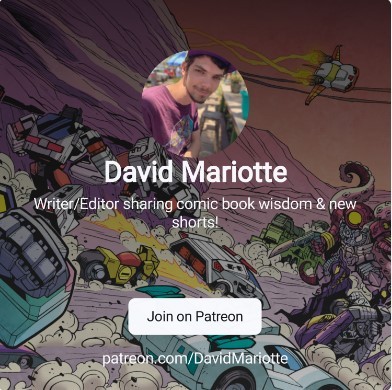
Do you not want to read this pitch for my Patreon? Good news: If you subscribe to it, this is cut out from the blog! Ooo aah!
Lastly, because of SDCC, expect no or a very short blog next week. And Becca's Twitch stream won't be back until the 25th, I believe. But in the meantime, Becca's own Patreon has been very active, including some stuff they recently drew on stream! And their webshop is current (though orders won't ship til after SDCC). It's Non-Binary Awareness week and San Diego Pride, so now's a good time to support them!

Pic of the Week:
I was in Old Town earlier this week and saw this very fun display of "Sonic" hats. Love that they come in every color.

#wga solidarity#sag solidarity#entertainment ethics#6 figure theory#entertainment hot takes#eat the rich#sonic idw#sonic sdcc 2023
130 notes
·
View notes
Text
Treetop Biopak: Compostable packages
Treetop Biopak, a UK-based company, produces compostable bioplastic packages. Their bags and films are durable, food grade, water- and puncture-resistant, and printable, making them suitable as packaging for bakery products, fresh produce, retailing, e-commerce, food service, electronics, clothes, etc.
The biopolymers Treetop Biopak uses in manufacturing are made from renewable resources, such as high-sugar plants like corn, sugar, and beetroot, and from a chemically engineered compostable fossil-based resin.
Unlike fossil-fuel-based plastics, bioplastic is compostable and breaks down under certain conditions and time frames to give compost, carbon dioxide, and water. According to Treetop Biopak:
Home compostable food-grade bags and cling film can be composted in gardens.
Tubular nets, adhesives, and shrink films need industrial composting facilities that use higher than ambient temperatures of 55 to 60°C to break down the bioplastic.
No microplastics are formed during this composting process, so Treetop Biopak helps to tackle the growing problem of plastic waste.
#solarpunk#solarpunk business#solarpunk business models#solar punk#startup#reculture#compostable packaging#compost
7 notes
·
View notes
Text
the way the 'the rest is entertainment' podcast has a vicegrip on me...maybe it's the combination of my interest in film + my working in the film & tv industries (the episode about FAST distribution a few weeks ago!!! hello!!! they are speaking TO ME) + my unrelenting love of celeb gossip = this is just the perfect podcast for me...but in this day and age when our attention spans are shrinking by the day and we all have internet brainrot...nothing keeps me sat and paying attention like this fuckin pod. and i know i complain about marina. she is so stuck up and she hogs the mic and sometimes i just need to pause in the middle of her ten-minute-long rants and do a lap. but she also speaks at x2 speed and she will say the meanest shit lmfaooo idk anyways i'm just listening to the new ep about the emmys and thinking about how it's actually cute how engrossed i am lmaooo
17 notes
·
View notes
Text
Hollywood has an inclusivity problem. How is this possible, in 2024, you wonder, when films like King Richard or Sound of Metal or Everything Everywhere All at Once—all nominated for Best Picture Oscars—suggest otherwise. They are films rich in story, dimension, and purpose. They are also exceptions to a long-established rule: White men still run Hollywood. Women remain almost entirely shut out, compared to their male colleagues, while disabled and Black actors are underrepresented in all major employment arenas for theatrical film, according to UCLA’s most recent Hollywood diversity report.
In the face of this, Kamala Avila-Salmon wants better for Hollywood and its storytellers. Avila-Salmon is the head of inclusive content at Lionsgate Motion Picture Group, where she began her stint in 2020 and has since leveraged her experience as a marketing savant (she has held top-level roles at RCA, Universal Pictures, Google, and Facebook) to shift how the studio makes movies. At Lionsgate, her main directive is simple: to create a creative economy that allows for more attentive storytelling. Stories of magnitude and conviction, yes, but also ones with as much reach as possible. It begins, she tells me, by having an “audience-first” mindset.
This month she launched Story Spark, an online tool that helps creatives understand the limits of their scripts and hiring choices by pushing for inclusivity in all aspects (it resembles a BuzzFeed-style multiple-choice questionnaire). As AI threatens a shrinking workforce and streaming upends traditional viewership, Avila-Salmon believes Story Spark can be a bridge to a healthier future for Hollywood. “Story Spark isn’t telling you if the movie is good,” she jokes when we chat over Zoom. “I have no idea.” You don’t upload a script. There is no secret counsel of industry insiders judging your work behind the scenes. Story Spark is simply meant to challenge writers and filmmakers to create their most audacious work possible. And, yes, there will be plenty of notes.
13 notes
·
View notes